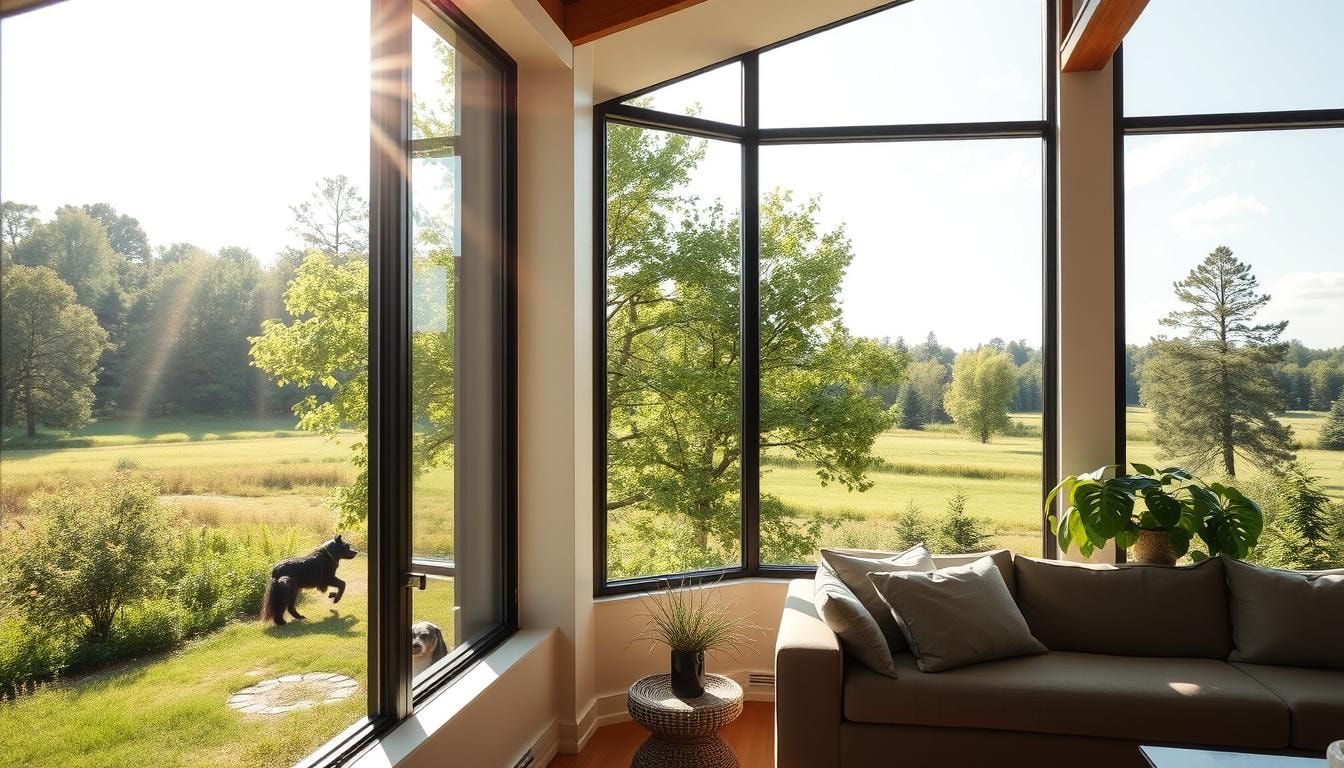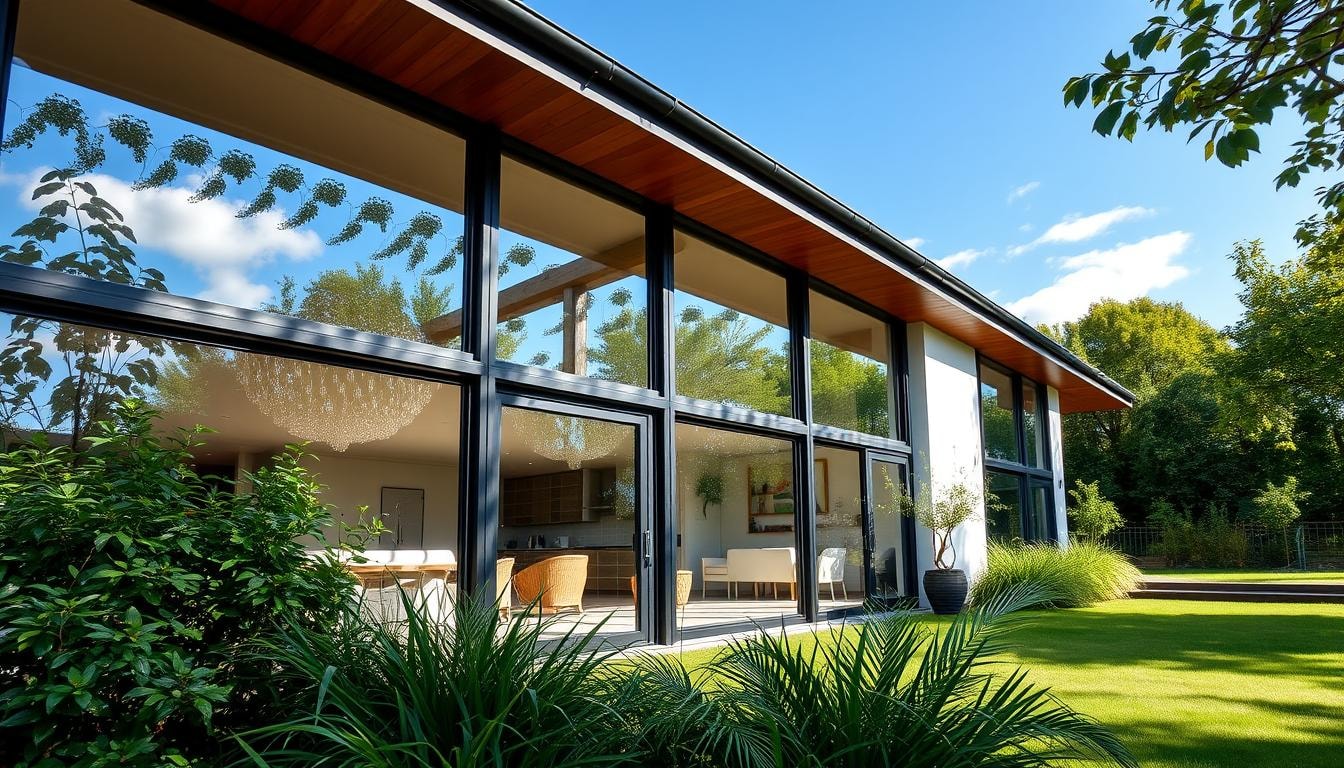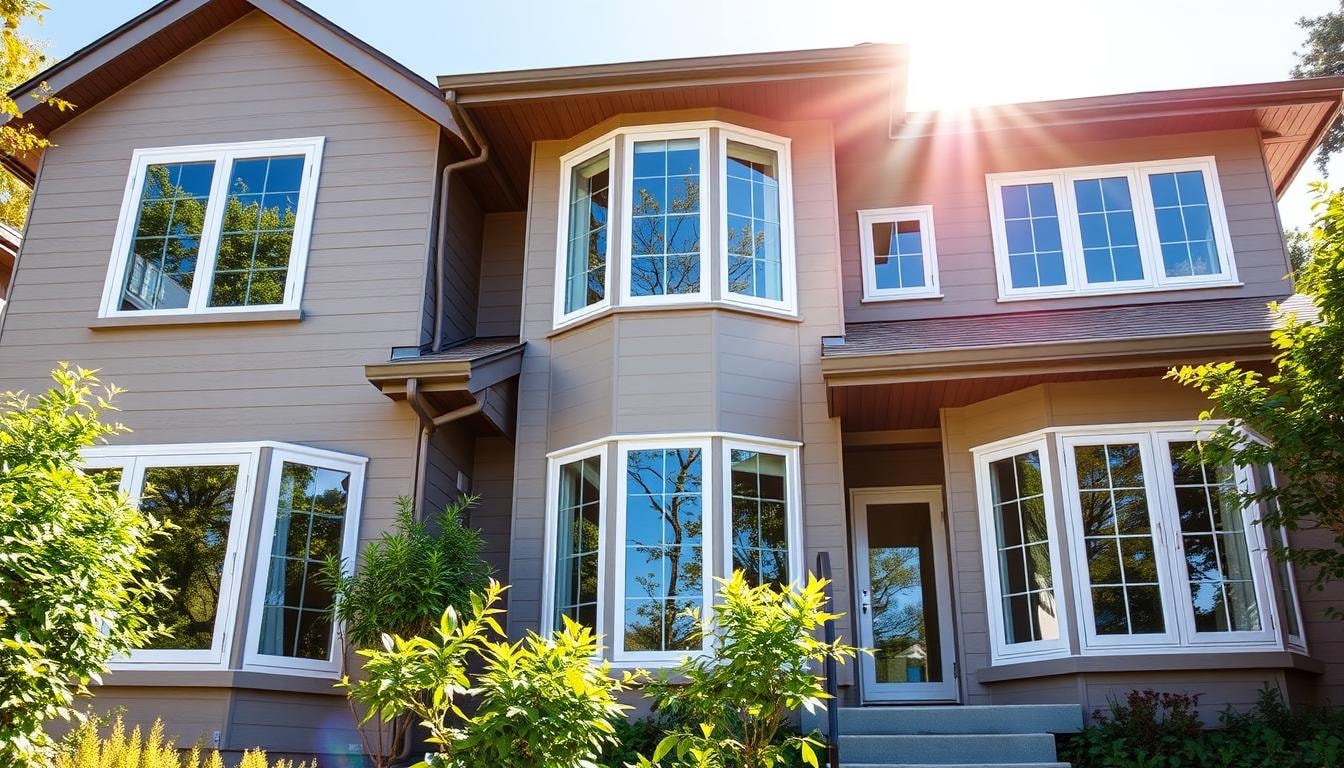
Compare Most Energy Efficient Windows: A Comprehensive Guide
Energy-efficient windows are key to saving money and making your home more comfortable. This guide explores the top energy-saving window types. We compare triple-pane, double-pane, and single-pane windows. These windows have special layers to keep heat out, saving you money all year, especially in cold or hot places.
This guide covers everything from what makes energy-efficient windows work to how they keep your home warm or cool. We look at how triple-pane and double-pane windows stack up. We also talk about the standards for energy efficiency and the materials used in windows. This helps you choose the best windows for your home.
Key Takeaways
- Triple-pane windows are the most energy-efficient, with three glass layers and two gas fills.
- Double-pane windows are very efficient, with two glass layers and one gas fill.
- Single-pane windows are the least efficient, with no extra layers or gases.
- Switching to energy-efficient windows can save a lot on your energy bills.
- Energy-efficient windows can really cut down your energy costs, but savings vary.
Understanding Energy Efficient Window Basics
Choosing the right windows can really help your home use less energy. Energy star certified windows help keep your home warm in winter and cool in summer. They use special glass, gas, and coatings to do this.
What Makes a Window Energy Efficient
Windows are energy efficient because of their frame, glass, spacers, and gas. The frame material, like vinyl or wood, helps keep heat out. The number of glass panes and the gas fill, like argon, also matter.
Low-E coatings help by reflecting heat. This means your home stays warmer in winter and cooler in summer. This saves you money on your energy bills.
Key Components of Energy Efficient Windows
- Multiple glass panes (typically double or triple)
- Insulating gas fills (argon, krypton) between panes
- Low-emissivity (Low-E) coatings to reflect heat
- Durable, insulating frames (vinyl, wood, or fiberglass)
- Warm-edge spacers to minimize heat transfer
The Science Behind Window Insulation
Energy-efficient windows work by stopping heat from moving through them. The glass panes and gas fills act as insulators. Low-E coatings reflect heat, keeping your home comfortable without needing to use as much energy.
Triple-Pane vs Double-Pane Windows: Performance Comparison
Homeowners often debate between triple-pane and double-pane windows. Triple-pane windows are better at keeping out cold and noise. But, they cost more.
Triple-pane windows can cost between $1,800 to $3,000 per window. This is 50% to 200% more than double-pane windows. They don’t save much more energy than double-pane windows. Plus, they might break more often.
Double-pane windows save a lot of energy and are cheaper. They come in many styles. Choosing between them depends on your budget, climate, and energy goals. Triple-pane is good for very cold places, while double-pane is better for most homes.
Choosing between triple-pane and double-pane windows is a big decision. Triple-pane windows are better, but they cost a lot more. Knowing your needs and climate helps pick the best windows for your home.
Rating Systems and Standards
Choosing energy-efficient windows means knowing about rating systems and standards. The Energy Star certification is key. It’s given by the U.S. Environmental Protection Agency. Windows with the Energy Star label are very good at keeping heat in and out.
Energy Star Certification Requirements
To get Energy Star certification, windows must be very energy-efficient. They must meet certain U-Factor and Solar Heat Gain Coefficient (SHGC) ratings. These are set by the National Fenestration Rating Council (NFRC).
Understanding U-Factor and SHGC Ratings
The U-Factor shows how well a window keeps heat in or out. Lower numbers mean better insulation. The SHGC shows how much sun a window lets in. Lower numbers are better for warm places, and higher numbers for cold places.
National Fenestration Rating Council Labels
The NFRC labels show how well windows perform. They give details on U-Factor, SHGC, and more. This helps people choose the right windows for their needs.
Knowing about Energy Star certification, U-Factor, SHGC, and NFRC labels helps homeowners. They can pick the best energy-efficient windows for their homes and climate.
Window Frame Materials and Their Impact on Efficiency
Choosing the right frame material is key for energy-efficient windows. Homeowners have many options, each with its own benefits. Knowing how frame materials affect energy savings can help you choose wisely.
Vinyl Frames: Vinyl frames are made of PVC and are great insulators. They help save energy and are often cheaper than wood frames. This makes vinyl a favorite among many homeowners.
Wood Frames: Wood frames are known for their insulation. They keep heat in and cold out, which is good for cold climates. But, they need more care than vinyl or fiberglass frames.
- Wood frames help keep heat in and bills down.
- They’re perfect for cold areas because they insulate well.
- Wood frames need regular upkeep to stay looking and working good.
Fiberglass Frames: Fiberglass frames are great insulators. They don’t let heat escape much, even in extreme weather. This makes them a top choice for homes in very cold or hot places.
Aluminum Frames: Aluminum frames are strong and look modern. But, they don’t insulate as well as other materials. New technology has made them a bit better, though.
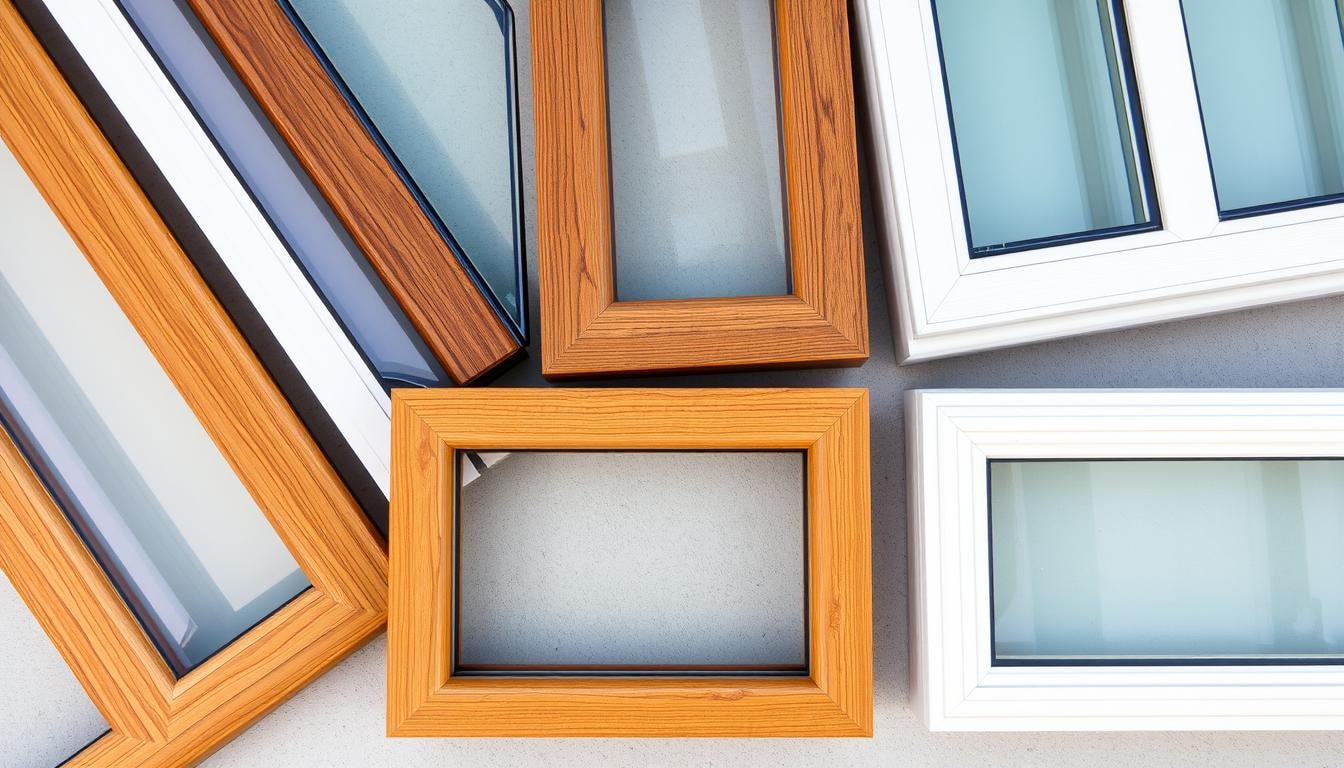
Choosing a window frame depends on your climate, budget, and what you like. Energy-efficient windows save money on bills. They’re a smart choice for any homeowner.
Low-E Glass Technology and Its Benefits
Low-emissivity (low-e) glass is a big deal for energy-saving windows. It has a thin, clear coating that bounces heat back. This keeps homes warm in winter and cool in summer. It’s made for different climates and preferences.
Types of Low-E Coatings
There are many low-e coatings to pick from, each with its own perks:
- Low-E4® glass reflects heat in summer and keeps it in winter. It’s good for places where you spend a lot on heating and cooling.
- SmartSun™ glass blocks 95% of harmful UV rays. It’s perfect for sunny places with lots of sun.
- PassiveSun® glass lets the sun warm homes in cold climates. It’s great for homes that use the sun’s heat.
- HeatLock technology stops heat from leaving your home. It’s best for cold places with air exchangers or dehumidifiers.
- Sun glass is tinted to block solar heat. It’s ideal for hot places where cooling is key.
SmartSun glass with HeatLock tech works well in mild to hot climates. It cuts down on solar heat and keeps air conditioning in.
UV Protection Features
Low-e glass also protects against harmful UV rays. It blocks up to 95% of UV radiation. This helps keep your home’s interior looking great and prevents fabric fading.
Solar Heat Control Properties
Low-e glass is great for controlling solar heat in hot climates. It reflects solar radiation. This helps lower cooling costs and keeps your home comfy, saving energy.
Gas Fills and Spacer Technologies
Gas fills and spacer technologies are key to making windows more energy-efficient. Inert gases like argon or krypton are used between glass panes. They are denser than air, which helps keep heat in.
Warm edge spacers are also crucial. They are made from materials like foam or stainless steel. These spacers stop heat from escaping at the edges of windows. This prevents condensation and boosts the window’s energy efficiency.
Things like the quality of the spacer seal and how well the window is installed matter. So does air pressure, humidity, and the climate. Gas-filled windows can lose gas over time, affecting their performance.
The material of the spacer is also important. Foam spacers, for example, are very energy-efficient. They help keep heat in better than other materials. Thermoplastic spacers also offer a tight seal, improving efficiency.
Using advanced gas fills and spacers can make windows more energy-efficient. This leads to lower utility bills and a more comfortable home.
Climate Zone Considerations for Window Selection
Energy-efficient windows vary by climate zone. Your home’s location affects the best window choice. Knowing your climate zone helps you pick windows that save energy.
Northern Climate Requirements
Northern homes face long, cold winters. They need windows that keep heat in. Look for windows with low U-factors to prevent heat loss.
Triple-pane glass and gas fills like argon or krypton offer better insulation. They help lower heating costs in winter.
Southern Climate Specifications
Southern homes deal with hot temperatures and lots of sunlight. Windows in these areas should block heat gain. This reduces cooling costs.
Windows with low Solar Heat Gain Coefficients (SHGC) block sun’s heat well. Low-E coatings and tinted glass also help control solar heat.
Mixed Climate Recommendations
Mixed climates have both hot summers and cold winters. You need windows that balance insulation and solar control. Double-pane windows with low-E coatings are a good choice.
They help manage cooling and heating costs all year. Always check the Energy Star program’s guidelines for your area. They offer the best window choices for energy efficiency.
Cost Analysis and ROI of Energy Efficient Windows
Buying energy efficient windows might cost a lot upfront. But, the long-term savings and benefits are worth it. The price of these windows changes based on size, type, and material. Vinyl frames are often cheaper, while fiberglass is more efficient but pricier.
The type of glass also affects the cost. Triple-pane windows with argon gas are great for cold places. They save a lot on heating and cooling. But, they cost more than double-pane windows.
- Fixed windows are the most sealed and energy-efficient, offering better insulation.
- Casement windows are more efficient than sliding windows because they seal tighter.
- Double-pane windows work well for most climates, beating single-pane designs.
Even though they cost more at first, energy efficient windows save a lot on bills. They have an average ROI of 67%, says Remodeling magazine. Homeowners might also get tax credits and grants for these windows.
Energy efficient windows also make your home more comfortable and valuable. They keep the temperature steady all year. Plus, they block noise and UV rays. So, the cost of these windows is an investment that pays off in the long run.
Installation Factors Affecting Window Performance
Getting windows installed right is key for saving energy. Professional installers make sure they fit and seal well. But, DIY can lead to bad sealing and less energy saving. Homeowners should watch out for mistakes that hurt a window’s energy-saving power.
Professional vs DIY Installation
It’s best to get a pro to install your windows. They know how to place and seal them right. This is important for keeping your home warm or cool.
But, doing it yourself can cause problems. You might not seal it well, leading to air leaks and less energy saving.
Common Installation Mistakes to Avoid
- Inadequate insulation around the window frame: Gaps or voids in the insulation can create thermal bridges, allowing heat transfer and compromising the window’s energy efficiency.
- Improper flashing: Incorrect installation of the waterproof flashing material can lead to water infiltration, negatively impacting the window’s performance and the home’s overall energy efficiency.
- Failure to level the window: Unleveled windows can result in air leaks and improper sealing, diminishing the window’s ability to maintain the home’s energy efficiency.
By avoiding these mistakes and working with pros, you can make sure your windows work well. This helps your home’s energy efficiency a lot.
Environmental Impact and Sustainability Benefits
Energy-efficient windows help a lot in reducing greenhouse gas emissions. They use less energy, which means less carbon footprint. The Environmental Protection Agency says these windows are key in fighting climate change.
Studies show energy-efficient windows can cut energy use by up to 25%. This saves about 1.1 million barrels of oil every day in the U.S. They also reduce heat transfer by 25-50% compared to old windows, saving a lot of energy.
These windows also block up to 90% of harmful UV rays. They cut solar heat gain by 40-70%. Replacing old windows with Energy Star certified ones can save homeowners 12% on bills, which is good for the planet and wallet.
Energy-efficient windows do more than save energy. They cut CO2 emissions by 1,006 to 6,205 pounds a year. They also reduce noise by up to 75%, making homes quieter and greener.
Getting energy-efficient windows also boosts a home’s value. Homes with these windows sell for more because they save energy and are eco-friendly. This makes them popular among buyers and helps the real estate market be more sustainable.
In short, energy-efficient windows are key for a greener future. They cut down on emissions and energy use, helping protect the environment. As more people and governments see their value, we’ll move closer to a more sustainable world.
Maintenance Tips for Optimal Energy Efficiency
Keeping your windows in good shape is key to saving energy and keeping your home comfy all year. Regular care makes your windows last longer and work better. This means you save more on energy costs.
First, check and replace any old weatherstripping around your windows. This small step can stop air leaks and boost your windows’ efficiency. Also, clean the tracks and weep holes to keep your windows working smoothly and draining right.
- Look for air leaks like drafts or fog on your windows. Fix any gaps, cracks, or broken parts right away.
- Keep your windows and frames clean to avoid dirt and debris. This helps your windows stay energy-efficient.
- If your windows are damaged, like cracked seals or broken parts, fix or replace them fast. This keeps your energy savings going.
By following these tips, your windows will keep your home comfy and your energy bills low. Remember, taking care of your windows now means better energy savings later.
Window Styles and Their Energy Performance
Not all windows are the same when it comes to saving energy. Knowing how different windows work can help you choose the best for your home.
Fixed vs Operable Windows
Fixed windows, like picture windows, are very good at keeping energy in. This is because they don’t open and close. Operable windows, like double-hung and casement, let in air but might not be as tight.
Casement windows are the best among operable ones. They seal well when closed, saving energy.
Popular Energy Efficient Designs
Picture windows are great for keeping energy in because they don’t open. Casement windows are also good because they seal tight when you close them. Awning windows open outward and are good for both energy and function.
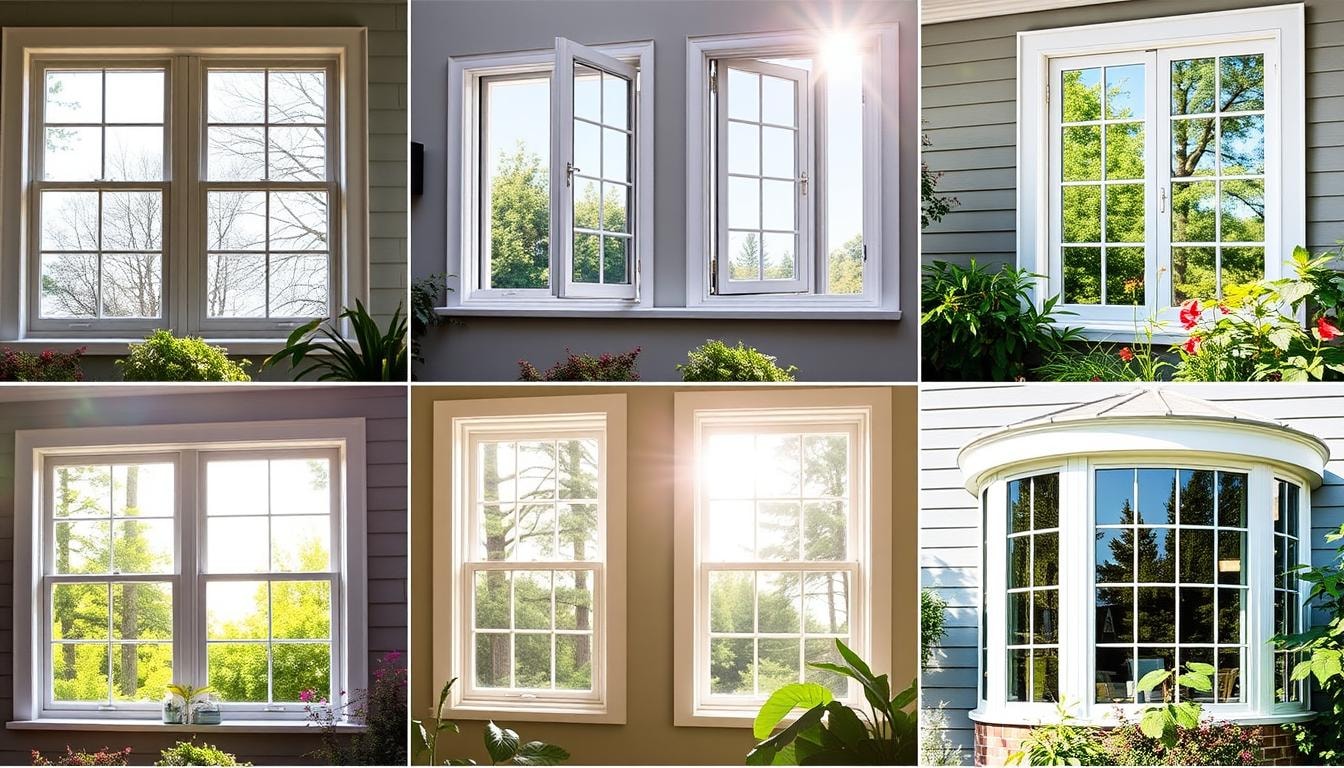
Choosing the right window is key to saving energy at home. Knowing about fixed, operable, and energy-saving windows helps you pick the best. This makes your home more comfortable and saves money in the long run.
Contact Budget Windows for Your Energy Efficient Solutions
If you’re looking to make your home more energy efficient, Budget Windows is here to help. Our team of experts can guide you in choosing the best windows and doors that meet your needs, ensuring lower energy bills and improved comfort. Contact us today to explore energy-efficient products and get a quote for new windows and doors that will transform your home into an energy-efficient haven.
Conclusion
Energy-efficient windows bring many benefits to homeowners. They save a lot of energy, make homes more comfortable, and are better for the planet. When picking the best windows, think about your climate, the style you like, the material, and special features like Low-E coatings.
Even though energy-efficient windows cost more upfront, they save money on bills over time. They can also make your home worth more. Plus, you can get help from the government and local programs, making them a good choice.
To get the most out of these windows, choose wisely, have them installed by pros, and keep them in good shape. By doing this, you’ll enjoy a cozy, green, and efficient home for many years.
FAQs
What are the most efficient windows for reducing heating and cooling costs?
Triple-pane windows with low-E coatings and gas fills offer the most efficient windows, helping reduce heating and cooling costs.
How do energy efficient windows help with winter and heat gain?
Energy-efficient windows, such as double-pane and triple-pane windows, help manage winter heat loss and heat gain during hot months by controlling the amount of energy entering and leaving your home.
Can replacing single-pane windows really lower energy bills?
Yes, replacing single-pane windows with energy-efficient windows significantly reduces heating and cooling costs, leading to lower energy bills.
How can window companies help identify energy efficient products for my home?
Window companies help identify energy-efficient products by recommending windows based on the most efficient criteria, including window glass, insulation properties, and energy performance.
What impact do storm windows have on energy efficiency?
Storm windows add an extra layer of protection, providing superior insulation properties and helping reduce heating and cooling costs.





